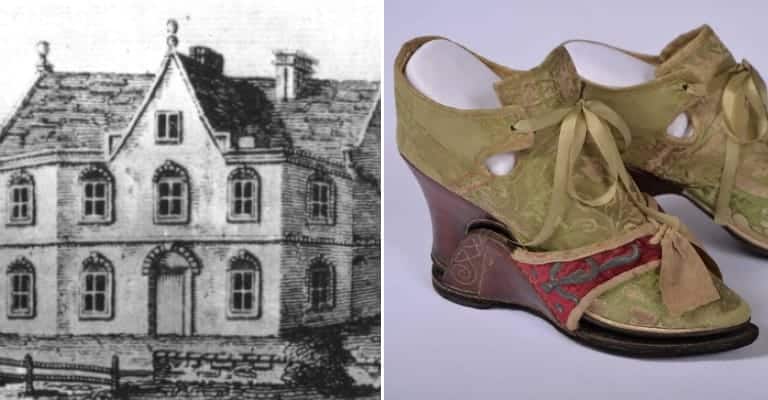Nothing remains of Papillon Hall. In 1950, after years of being left to rot and decay while waiting to be sold, it was finally demolished, an unwanted relic of the past. However, in its day, the Hall was an impressive building. It was constructed in 1622 by military engineer David Papillon as his family seat. Fortress-like, the octagonal shaped house loomed over the land surrounding the village of Lubenham in Leicestershire.
Today, a very ordinary farm occupies the land. The only traces of the once grand country house are its overgrown gardens, perimeter wall, stables- and a pervading sense of unease. For although the house has gone, its reputation remains. For Papillon Hall was the quintessential English haunted house, complete a cursed portrait a very temperamental pair of Lady’s slippers, and eerie history. That history began in the fourteenth century when the land was in the hands of Leicester Abbey.

The Legend of “Pamps”
In 1303, Edward I asked the abbot of the Abbey of St. Mary de Pratis in Leicester to grant a “corrody,” of food, clothing, money or land to one William Papillon for his services to the crown. The Abbot obeyed and awarded William land near the village of Lubenham. The area came complete with a Chalybeate well with reputed healing properties- and the Abbey leper colony. For the next couple of hundred years, the Papillon family ignored their Leicester property. They had come over to England from France at the time of William the Conqueror, and it was to France they returned.
In 1588, the family was back in England, fleeing the Huguenot persecutions in France. The Papillons reestablished themselves in English society and in 1622, David Papillon; a military engineer began to construct an impressive country seat on the land at Lubenham. Papillon Hall took two years to build, and its design showed the influence of David Papillon’s military background. The octagonal shaped house occupied the highest point of the estate, the land sloping away from it on all sides. It had just one entrance and was rumored to be surrounded by a moat! Even the roof of the house was a defensive feature. The gables, which formed a cross shape were paved with lead on either side to create platforms accessible from the attics. Cannons were stationed on the platforms, as if ready to defend the house.

The Papillon’s only occupied Papillon Hall for a few generations. The last Papillon to live in the Hall was it’s builder’s great-grandson, also called David but better known locally as “Lord Pamp,” or just “Pamps.” Pamps was in his early twenties when he became the master of Papillon Hall. However, he also had a sinister reputation as a mesmerist. One look from Pamps was reputedly enough to force his victims to do his bidding. One Lubenham tale told how two of Pamp’s farm laborers made a bad job of plowing a field. Pamps convinced the shoddy work was due to laziness, mesmerized the men so that they were unable to move until he released them at the end of the day.
Pamps was also rumored to keep a mysterious Spanish mistress within Papillon Hall. No one ever saw the strange woman, as Pamps would not allow her to leave the building. However, it was whispered she occupied one of the attic rooms and roamed the lead flats after dark. Then in 1715, the lady reputedly died, and two years later, Pamps married and left Papillon Hall for Kent, never to return. However, before he departed, he left precise instructions regarding some of the house’s contents. One was a portrait of Pamps himself, painted in 1715. The other was a pair of green and silver brocade lady’s slippers. Pamps ordered that under no circumstances were either of these items ever to leave Papillon Hall.

